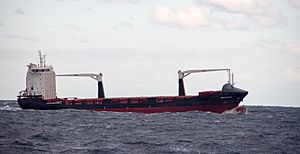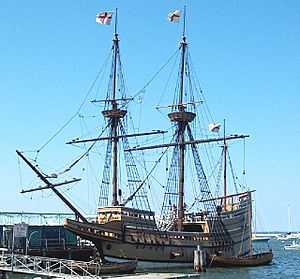Ship facts for kids
| General characteristics | |
|---|---|
| Tonnage | to 120,000 DWT (New Panamax) |
| Length | to 289.56 m (950 ft) (New Panamax) |
| Beam | to 134 ft (41 m) (Gerald R. Ford-class aircraft carrier on waterline) |
| Draft | to 15.2 m (50 ft) (New Panamax) |
| Propulsion | steam turbine (fossil fuel, nuclear), diesel, gas turbine, sterling, steam (reciprocating) |
| Sail plan | for sailing ships – two or more masts, variety of sail plans |
A ship is a large watercraft that travels the world's oceans and other sufficiently deep waterways, carrying passengers or goods, or in support of specialized missions, such as defense, research and fishing. Historically, a "ship" was a sailing vessel with at least three square-rigged masts and a full bowsprit. Ships are generally distinguished from boats, based on size, shape, load capacity, and tradition.
Ships have been important contributors to human migration and commerce. They have supported the spread of colonization and the slave trade, but have also served scientific, cultural, and humanitarian needs. After the 15th century, new crops that had come from and to the Americas via the European seafarers significantly contributed to the world population growth. Ship transport is responsible for the largest portion of world commerce.
As of 2016, there were more than 49,000 merchant ships, totaling almost 1.8 billion dead weight tons. Of these 28% were oil tankers, 43% were bulk carriers, and 13% were container ships.
Contents
History
Early ships
The first ships used oars or the wind (or both) to make them move.
From about 4000BC the Ancient Egyptians were making wooden sail boats. By 1200BC the Phoenicians and Greeks had begun to make bigger sailing ships which were about 30 metres (100 feet) long and could carry 90-180 tonnes of cargo. The Romans made even bigger ships which could carry up to 1,000 people and 1,000 tonnes of cargo. The 8th century saw the rise of the Vikings, who were famous for their "longships" and which were mainly used for raiding other countries, but also for trading. The longships had flat bottoms so they could move in shallow (not deep) rivers.
Age of sail
Sailing ships were used for thousands of years, but they were very important in wars and trade from the 1500's to the 1800's. The Chinese admiral Zheng He commanded a fleet of 'treasure ships' on seven voyages all over Asia up to East-Africa in the early fifteenth century. These ships probably were about 130 m (450 ft) long and up to 50 m (180 ft) wide. That makes them about twice the size of the largest European ships in the sixteenth century. The most successful and largest fleet in the 17th century was the Dutch fleet (see the Netherlands). For trade and transport the Dutch often used a particular kind of trading ship, called a flute (fluit in Dutch). Transport of people and cargo on sailing ships continued until the 1920's.
Some famous ships from this era include:
- Niña, Pinta, Santa Maria - Christopher Columbus' ships
- The Mayflower - The ship that carried the Pilgrims to Massachusetts
- Queen Anne's Revenge - The pirate Blackbeard's ship
- HMS Bounty - Captain Bligh's ship. Site of the most famous mutiny of all time
- USS Constitution - The most powerful ship in the early United States Navy
- HMS Victory - Admiral Horatio Nelson's flagship at the Battle of Trafalgar
The age of steam
In the 19th century, steam ships were invented.
At one time, the steamships Titanic, Olympic, and Britannic were the largest ships in the world, Titanic sank on her maiden voyage after hitting an iceberg, becoming one of the most famous shipwrecks of all time, the Olympic was Titanic 's nearly identical twin, and actually set sail before Titanic and was scrapped in the 1930's after a very successful career including her being a passenger liner and a warship in World War I. The Britannic was the largest of these three sister ships, and was supposed to be more grand and elegant than the Titanic, but before she set sail on her maiden voyage, WWI broke out and she was stripped of her elegant furniture and elaborate paneling and became a hospital ship. During her term as a hospital ship, she was sunk by either a mine or torpedo, no one knows for sure. The Titanic lies at the bottom of the North Atlantic Ocean, off the coast of Nova Scotia, and the Britannic lies in the Aegean Sea, off the coast of the Island of Kea.
Modern ships
After World War II ships with diesel engines became commonplace. Passenger airliners replaced passenger ships for long trips in the late 20th century. Cargo ships became much bigger. The main kinds are container ships for mostly manufactured goods, and bulk carriers including oil tankers.
Largest ship
The world's largest ship is the Prelude, owned by Shell. It is being built on Geoje Island, South Korea. It is 488m long and has the internal capacity greater than the total volume of four large aircraft carriers. What it will do is collect natural gas off the coast of Australia, and liquify it. When liquified, the hydrocarbon takes up 600 times less space than its gas. Smaller tankers will take the liquid gas to its buyers. The ship will do liquifying and temporary storage, which is usually done on land. Shell believes this justifies the cost of the ship.
The shipping yard builds all kinds of structures for the oil industry. It employs 30,000 workers.
Some names for parts of a ship
- Amidships - near the middle of the ship.
- Bow - the front of the ship.
- Stern - the back of the ship.
- Aft - in the direction of the stern.
- Astern - behind the ship.
- Starboard - the right side of the ship.
- Port - the left side of the ship.
- Bridge - the room in which the ship is controlled.
- Cabin - a room where a crew member lives.
- Decks - the floors.
- Galley - the kitchen.
- Hold - an area inside the ship used to carry goods.
- Hull - the main body of the ship.
- Keel - a beam running from stern to bow.
- Mast - a central pole on which sails are hung.
- Brig - Prison cells in the ship.
Some types of ships
- Bulk carrier - very large ship used for carrying very heavy cargo.
- Catamaran - a ship with two hulls.
- Cruise ship - a large passenger ship that takes people on holiday or vacations.
- Ferry - a passenger ship which often carries vehicles as well as people.
- Supertanker - a very large ship usually used for carrying oil.
- Warship
- Aircraft carrier - a warship which carries aircraft
- Battleship - a large warship
- PT boat- a small warship
- Submarine - an underwater boat
Images for kids
-
Fijian voyaging outrigger boat with a crab claw sail
-
A Roman ship carved on the face of the "Ship Sarcophagus", c. 2nd century AD
-
Replica of Magellan's Victoria. Ferdinand Magellan led the first expedition that circumnavigated the globe in 1519–1522.
-
Painting of the Battle of Trafalgar by Auguste Mayer.
-
Italian full-rigged ship Amerigo Vespucci in New York Harbor
-
RMS Titanic departs from Southampton. Her sinking led to tighter safety regulations
-
Colombo Express, one of the largest container ships in the world, owned and operated by Hapag-Lloyd of Germany
-
Ship carrying containers in Gadiara (West Bengal, India)
-
Passenger ship of Köln-Düsseldorfer on the river Rhine
-
Hurma, Hans and Voima at the Lake Saimaa in the harbour of Imatra, Finland, at a heritage ship meeting in 2009
-
Two modern container ships in San Francisco
-
Albatun Dos, a tuna boat at work near Victoria, Seychelles
-
American aircraft carrier USS Harry S. Truman and a replenishment ship
-
The rudder and propeller on a newly built ferry
-
MS Freedom of the Seas under construction in a shipyard in Turku.
-
A ship launching at the Northern Shipyard in Gdańsk, Poland
-
Workers drag steel plate ashore from beached ships in Chittagong, Bangladesh
-
The tanker Exxon Valdez spilled 10,800,000 US gallons (8,993,000 imp gal; 40,880,000 L) of oil into Alaska's Prince William Sound.
-
Ship breaking near Chittagong, Bangladesh
See also
 In Spanish: Barco para niños
In Spanish: Barco para niños






























